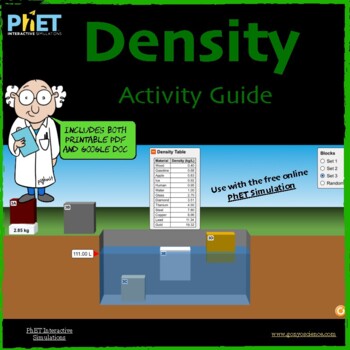PhET Density Activity Guide
- Zip
- Google Apps™
- Easel Activity

What educators are saying
Also included in
- Now includes both printable PDF and Google Slides versions!The PhET Physics Activity Guides are used along with the free *Next Generation PhET Simulations. All activity guides are in PDF and Google Slides formats and include an answer key and a Getting Started Guide for teachers.Your students will hPrice $27.00Original Price $30.00Save $3.00
Description
The PhET: Density Activity Guide is used along with the free *Next Generation PhET Simulation “Density”. Students will discover how density relates to an object's mass and volume, specifically:
- how objects of similar mass can have different volumes
- how objects of similar volume can have different mass
- how to measure the volume of an object by water displacement
- how to identify an unknown material by calculating its density and comparing that to a table of known densities
The activity guide takes students through the 3 parts of the simulation: Intro, Compare, and Mystery. Students are encouraged to make predictions as to the effects of changes in mass, volume, and density and then to experiment to discover how these changes affect the density and buoyancy of an object.
Your students will hit the ground running without the need for a lengthy introduction from you. Just print the activity guide or share from your Google Drive. Students can follow the link to the free simulation. The best part is that students don’t even know they are learning, they just think they are having fun!
The activity guide includes both PDF and Google Doc versions for printing worksheets or sharing via Google Drive or Google Classroom. This lesson is perfect for face to face, hybrid, or remote learning!
This product includes the Activity Guide in color (pdf), Activity Guide for photocopying (pdf), Activity Guide (Google Doc), Answer Key, and a Getting Started Guide for teachers.
*PhET simulations are fun, interactive, research-based simulations of physical phenomena. As students interact with the simulation, they get immediate feedback about the affects of the changes they made. All PhET simulations are freely available from the PhET website (phet.colorado.edu) and are easy to use and incorporate into the classroom. The new Next Generation sims utilize HTML 5 which allows them to run in any modern web browser on most devices including Chromebooks and tablets like the iPad! Learn more about using PhET Simulations with your students.







